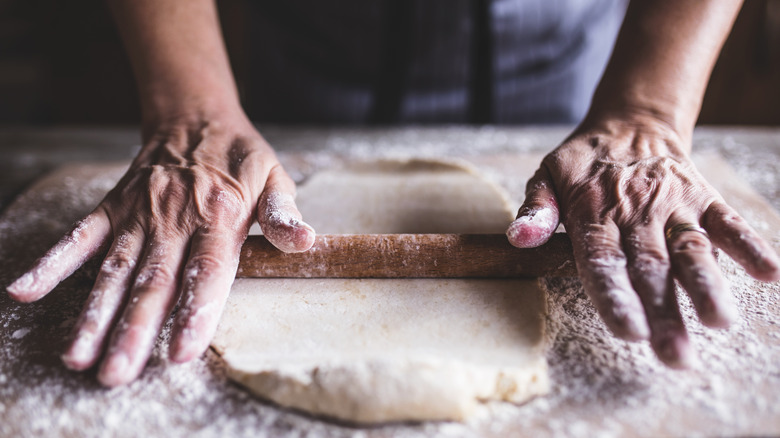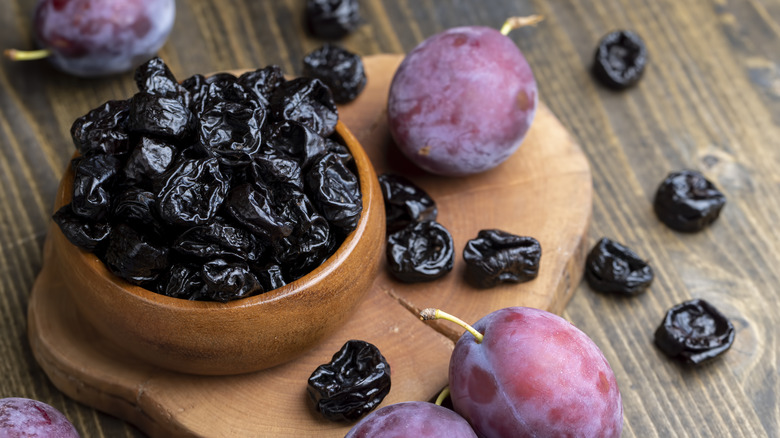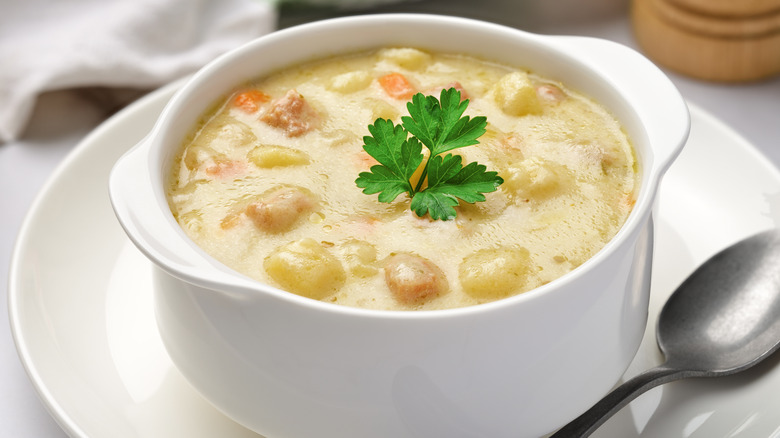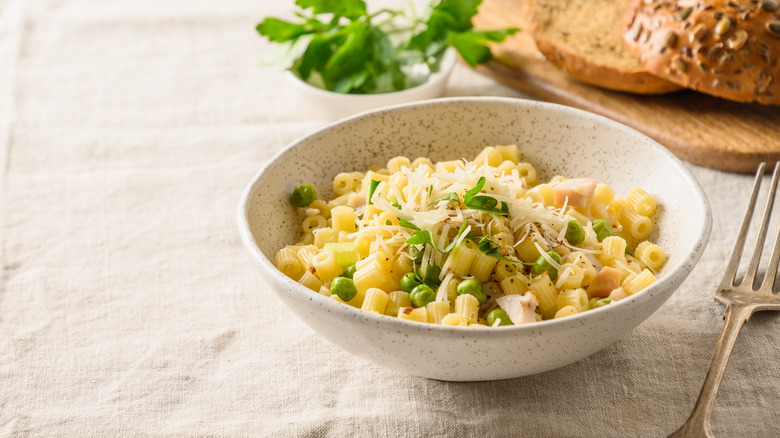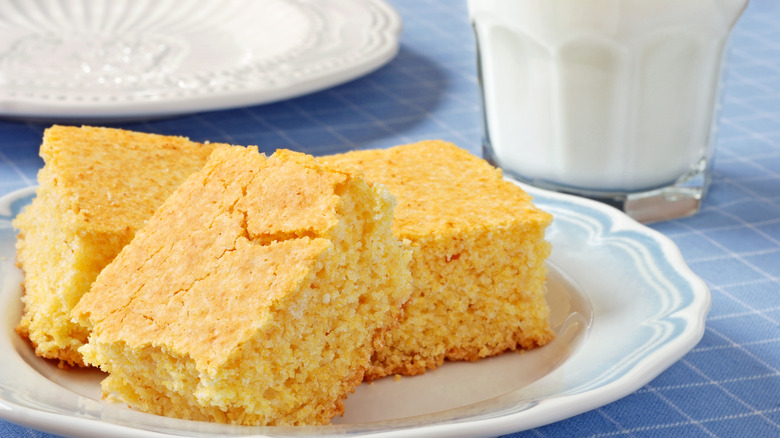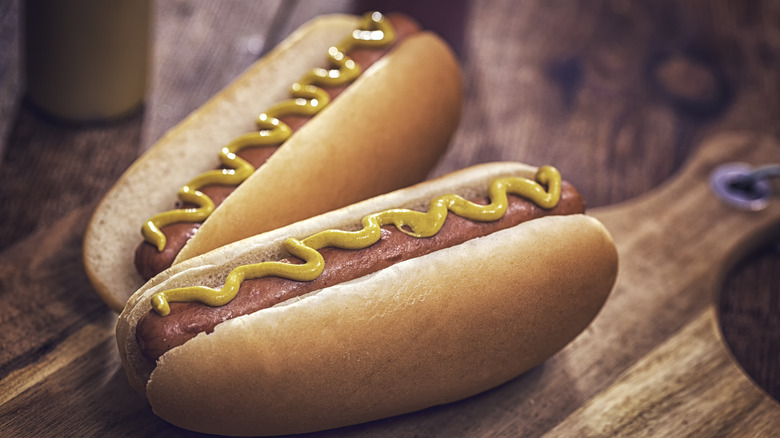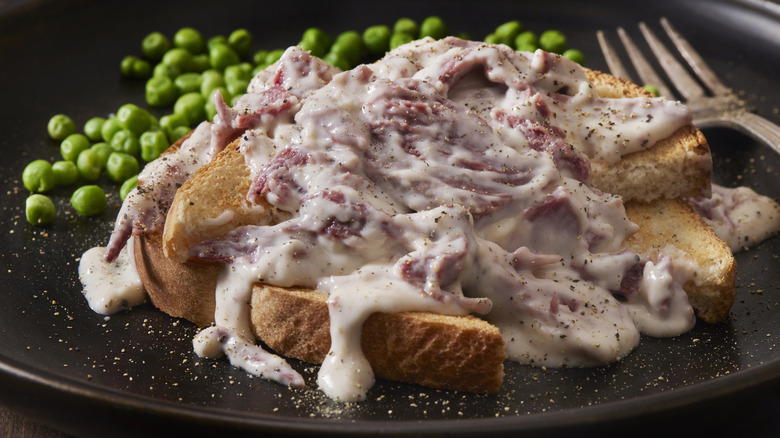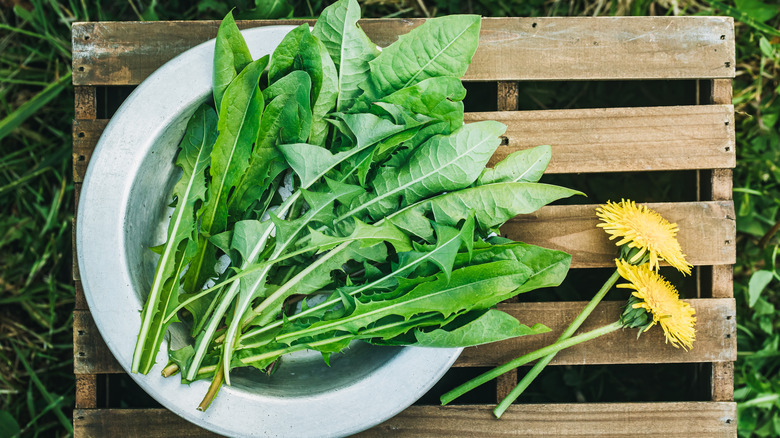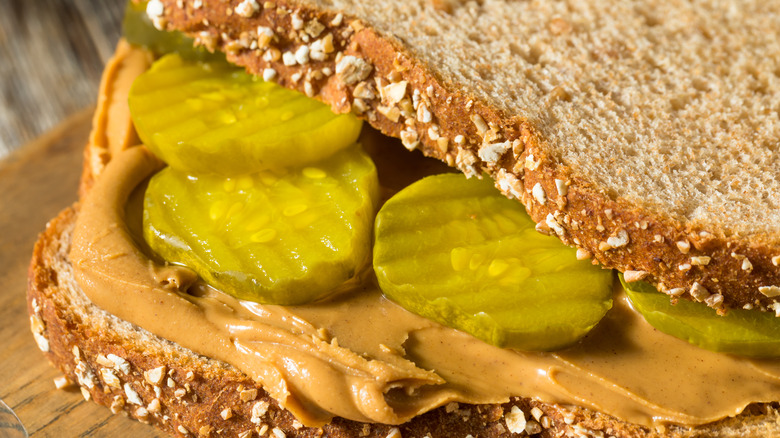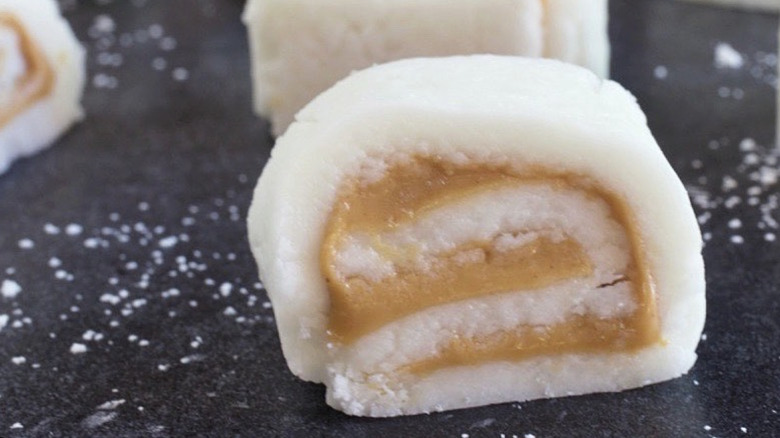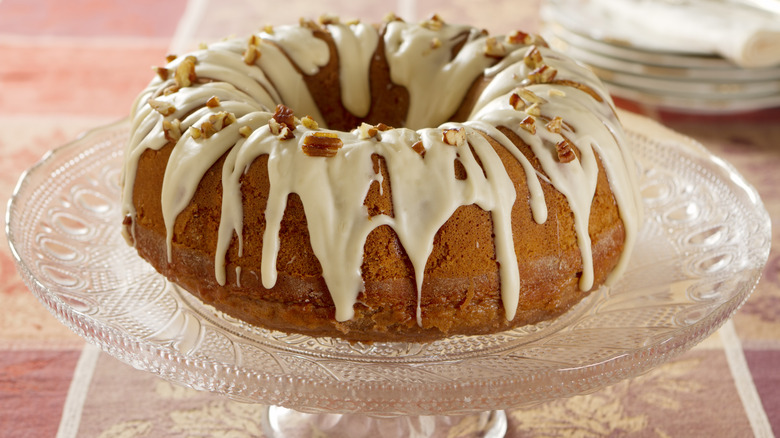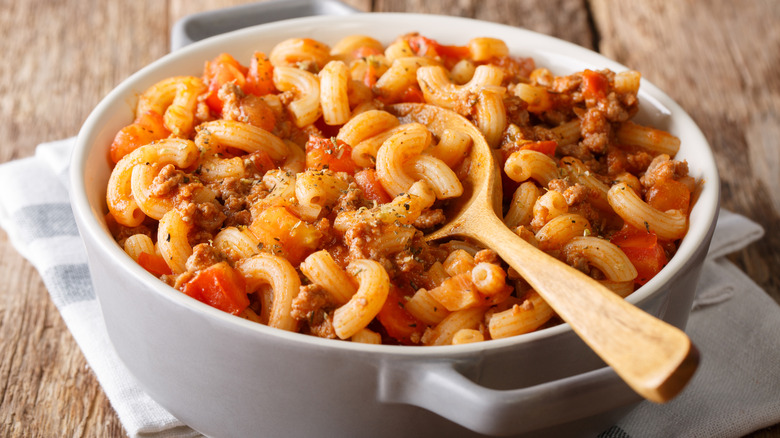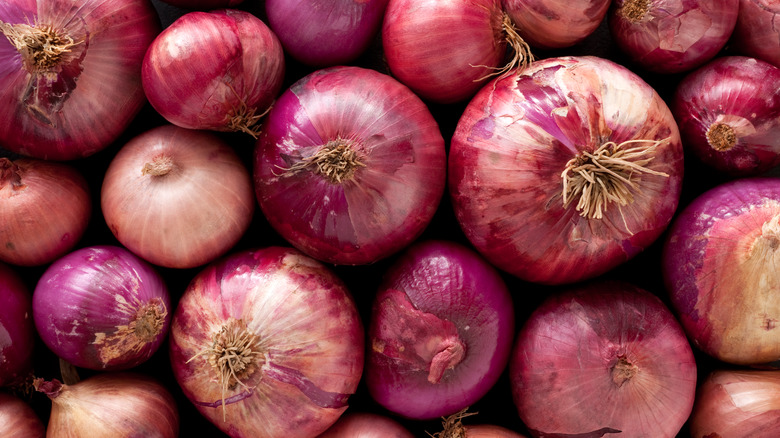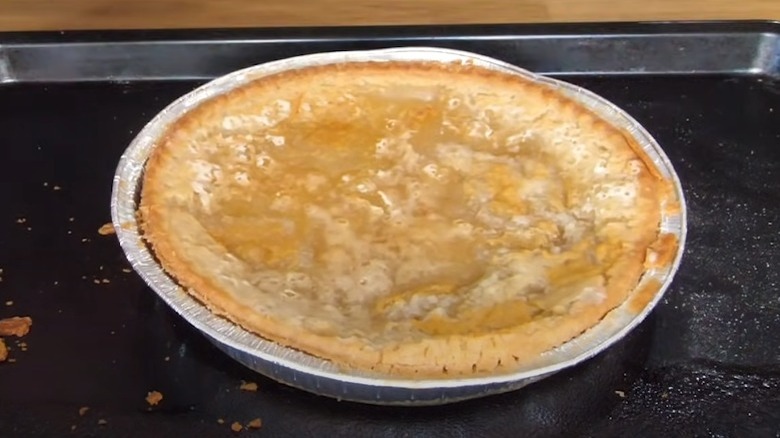13 Fascinating Foods Eaten During The Great Depression
When the stock market crashed in 1929, ushering in the Great Depression, the way Americans approached food and cooking drastically changed. For many people, sustained economic struggle led to forced creativity in the kitchen. Certain food items and ingredients were either no longer available or too expensive, such as fresh fruit and vegetables. Meals had to stretch for days but still be nutritious. This led to lots of innovative recipes that are both fascinating and familiar to us.
Some foods that were popular during the Great Depression might sound unpalatable, but they were products of ingenuity during a nearly impossible time. And guess what? We still enjoy some of these meals today. Maybe you remember your grandmother's "special stew" or your grandfather's myriad potato-based recipes. Maybe after a late night you've made a pasta recipe with whatever you could find in the cabinet. So, next time you find yourself paying for a farmer's salad with dandelion greens, think of how during the Great Depression, dandelion greens were a cheap (or free) way to get some much-needed vitamins and minerals — not just a trendy dish.
1. Prune pudding
Prunes remain strangely divisive among foodies — perhaps because we associate them with certain bathroom activities, perhaps because they seem rather boring. However, prune lovers extol the rich sweetness of the dried fruit, which remain very popular in Middle Eastern and Japanese cuisine. During the Great Depression, prunes were especially kind of a big deal. At the time, they were cheap, available, and easily preserved. Prunes are loaded with fiber and good for your digestion. They're kind of a super food.
What can you do with all this prune bounty? Make prune pudding, of course. Basically, the ingredients are prunes, sugar, and cinnamon — but you can be flexible with the spices. Out of cinnamon but have cardamon? That works!
The most famous example of prune pudding is then-first lady Eleanor Roosevelt's recipe. She served prune pudding at the White House to foreign dignitaries in an act of solidarity with struggling Americans. During the Roosevelts' tenure, the White House did not serve the most customarily fancy presidential foods, and Eleanor herself — with the assistance of dieticians — made up some recipes with mixed success.
2. Potato soup
Nowadays, potato soup can get quite fancy. Add crème fraîche, cauliflower, or fresh herbs and blend in leeks to elevate the flavors. But don't forget that the humble potato remains the main ingredient — and that was crucial for those preparing food during the Great Depression. Potatoes were a staple of many meals at this time, but adding them to soup was one of the most popular methods of preparation.
Potatoes are hearty and filling, but they're not precious. They're cheap to grow and don't require as much attention as other crops. You can pile a bunch of them in a basket and store them during the off-season. All you needed to do back then to make your potato soup stretch was cook them in some water, butter, and milk. Depending on what other ingredients you had around the house — maybe some onions — you could add that as well. Potato soup would make a comforting meal for a cold day.
3. Pasta and peas
Is pasta and peas Depression-era food or something you can order at your local Italian restaurant? Both! Lots of immigrant populations were trying to find their footing in the U.S. during the Great Depression, and they relied on their home traditions to keep the family fed. You might have heard of one famous name — Chef Boyardee. An immigrant from Piacenza, Italy, who eventually settled in Pennsylvania, Ettore Boiardi started the Chef Boyardee Food Company in 1928. The company's prepackaged spaghetti dinners helped lots of families through the Depression.
If you didn't have access to Chef Boyardee's products, though, you could make your own pasta dishes. Pasta and peas was popular because pasta was cheap and you could get peas canned. In general, canned foods were emphasized during the Great Depression. They were perceived to be scientifically better and fresher — at least that was the story advertising companies were selling.
4. Cornbread in milk
Baking with very little became an art form during the Great Depression. Made with a total of three ingredients — cornmeal, salt, and water — cornbread was simple and fast to make. This is a dense bread because it lacks yeast, but it's hearty. When the bread started to get hard or go stale, families would put the chunks or crumbles in a glass of milk or buttermilk and eat it that way as a sweet treat. Consuming cornbread this way very popular in the South, as well as in Appalachia.
According to ICE chef Chris Scott, to this day, a family's (often passed down) cornbread recipe can tell a lot about their history. "For example, if you're from the north, then your cornbread recipe probably has sugar or honey in it. If you're from the south there is most likely no sweetener. If you are from the Appalachians, then you might tend to prepare your cornbread in a very old-fashioned manner with no leaveners, using simply ground corn, hot water and lard," he wrote for the Institute of Culinary Education's blog Diced.
5. Hot dogs
If you have kids, you've probably had to buy hot dogs at the grocery store on many occasions — they're a favorite among the little gourmets in your life. But hot dogs were also a dinner saver during the Great Depression. Folks would chop up hot dogs and add them to bean-based stews, or they would eat them covered in pickles, onions, and mustard. Hot dogs were cheap, filling, and available — the three main criteria for a solid Depression-era food item.
As with many foods, there were regional variations. For example, Chicago's version is classically topped with mustard, relish, onions, tomatoes, pickles, peppers, and celery salt and comes in a poppy seed bun. These hot dogs were once called "Depression Sandwiches," and a local chain called Fluky's claimed to have come up with them. Chicago-style hot dogs were "really a product of the Great Depression," professor Bill Savage told Block Club Chicago. "A nickel could get you a hot dog with all these condiments on it that made it something approaching a full meal."
In Brooklyn, you could get a hot dog at Nathan's Famous on the cheap. In 1939, Franklin and Eleanor Roosevelt (yes, Eleanor again) even served Nathan's hot dogs to King George VI and Elizabeth of England.
6. Chipped beef and cream
Chipped beef and cream seems to have originated as an Army meal and existed at least as far back as 1910, and families looking to save money used the recipe during the Depression. Usually added to toast, creamed chipped beef was a popular meal because sliced, dry beef was available during the Great Depression, and it could keep for quite a long time on the shelf. People also called this meal "s*** on a shingle," which is nice.
The beef is kind of like thin jerky. It's salted, dried, pressed, and then sliced. You can get necessary protein from it — and after pairing with cream or a butter, milk, and flour mixture and slopping it on toast, you'd feel pretty full. The dish was very popular in Eastern Pennsylvania and New Jersey. In fact, at some Cracker Barrel and IHOP restaurants, creamed chip beef was once an item on the menu. While the dish is no longer available at those establishments, you can find it at Golden Corral.
7. Dandelion salad
Ah, dandelions. The pretty weeds. They grow everywhere — and their leaves are edible, making simple dandelion salad a popular option for Depression-era families looking to get some vitamins and minerals. Clara Cannucciari, a cook who, before she passed away in 2013, became well-known for her YouTube videos demonstrating how she prepared meals during the Great Depression, praised the plant in one such video for being "free and ... good for you." But if you decide to forage for your own dandelions, make sure they haven't been sprayed with pesticides!
You can also get dandelion greens at many restaurants. They're slightly bitter, depending on how young the leaf is, and many cooks like to brighten up the flavor of the greens with lemon and vinegar. You can add cheese, too, like pecorino. Get creative and throw in some beets or fennel. Also, why not sauté them? Or make them into a pesto with your favorite nut and olive oil? It seems like dandelion greens are ready for their second act.
8. Peanut butter and pickle sandwich
During the Great Depression, peanut butter was very cheap. It emerged in the Midwest during the 1890s, arguably invented by John Harvey Kellogg (yes, of Kellogg's cereals) and marketed for the masses. It gained further popularity when, in 1921, a California man named Joseph Rosefield used a chemical process called partial hydrogenation to make peanut butter shelf stable.
Guess what else can stay on the shelf for a long time? Pickles. So why not combine the two? Put them together on homemade bread, and there you go: a peanut butter and pickle sandwich. Does it sound gross? Maybe. But in fact, lots of people still make them, and new fans are converted daily.
Don't have pickles? You can use mayonnaise! Peanut butter and mayonnaise sandwiches were also pretty popular and promoted as healthy, protein-packed meals. Why don't you get a little wild and add all three ingredients together?
9. Potato candy
Even during times of scarcity, it's important to treat yourself. Potato candy was a way people during the Great Depression could have something sweet. Potato candy is said to have originated in Germany, but Americans added the peanut butter. The recipe was simple to make: You could whip a batch up with one potato (russet potatoes are best since they are simple to mash and don't taste overly robust), a lot of powdered sugar, milk, vanilla, salt, and peanut butter. Those who have made batches report that the candy is creamy and soft and doesn't really taste like potatoes — probably due to all the sugar.
If you're tired of hearing about peanut butter, though, don't fret. You have options! There are tons of other sweet, thick spreads that lend themselves to this recipe but just weren't around when potato candy was first created. Nutella and almond butter sound pretty tasty.
10. Tomato soup cake
A cake made from canned Campbell's tomato soup? This sweet treat is a kind of "spice cake" that was very popular during the Great Depression. Home bakers started adding tomato soup to cake batter in place of milk or buttermilk in the 1930s to make it moist. In fact, poet Sylvia Plath, who grew up during the later parts of the Great Depression, famously made tomato soup cake and other baked goods. When Plath moved to England, she sent a letter to her mother wondering about baking measurements: "How many ounces are there in an American tomato soup can you use for tomato soup cake? I didn't think to question, but our cans seem to be bigger than yours, as my cake was a bit 'wet.'"
The cake itself is quite festive tasting, especially with cream cheese frosting (which would not have been associated with it during the Depression). The addition of cinnamon, clove, nutmeg, and allspice gives the cake warmth, and the tomato soup is fascinatingly delicious and appropriate as part of that combination.
11. Hoover stew
Enjoy your Hoover stew while hanging out in your Hooverville (a Great Depression-era term for shantytowns) and wearing a Hoover blanket (a newspaper). A lot of unfortunate things became associated with President Herbert Hoover when the Depression hit — but Hoover stew isn't bad. This is in part due to its flexibility as a recipe. This Depression food staple is basically a "throw it all in" kind of soup starring canned or boxed pantry goods. "Traditional" ingredients included macaroni, hot dogs, tomatoes, and corn — but during the Depression, none of that was guaranteed to be available, so you just had to make it work somehow!
Lots of misses? Probably. Lots of hits? Probably. This meal was popular on soup kitchen lines and likely helped feed countless Americans who were struggling to make ends meet. And today? We've all had some kind of version of this meal when it's cold outside and we feel too lazy to make the trek to the grocery store.
12. Peanut butter-stuffed onions
Arguably way less popular than the peanut butter and pickle sandwich, this dish was another way to emphasize putting two available items together. Peanut butter-stuffed onions were a Depression staple created by the Bureau of Home Economics and promoted in advertisements. The bureau wasn't too concerned with taste at the time; it was trying to promote meal ideas that would help Americans feel full while getting necessary vitamins and minerals.
This ... striking-sounding dish was served hot, with the peanut butter stuffed into the onion's center and then the whole thing roasted for about an hour. Ernest Hemingway was a fan — kind of. He reportedly enjoyed peanut butter on white bread with slices of onion. In his novel "Islands in the Stream," he refers to this culinary mix as the "Mount Everest Special."
There are, of course, dishes that pair peanuts and onions very skillfully, especially in Thai cuisine. But there's a big difference between subtly combining flavors versus jamming a blob of peanut butter into a whole onion.
13. Water pie
Looking for an easy dessert? Look no further than Depression-era water pie. Basically, take an unbaked pie shell and put the following ingredients into it: water, flour, sugar, a tiny bit of vanilla extract, and some pats of butter. Then shove it in the oven.
During a time when fresh fruit pies were not a reality for many people, water pie was a reminder that even though times were difficult, there could still be sweetness. It was cheap, easy, and festive. People who have made this pie report that it tastes buttery but is less creamy than a traditional custard pie. Cookbook author and YouTube creator Barry Lewis described it as looking like "wallpaper paste pie" but felt it tasted good enough.
If you're curious about recreating this classic recipe, you can experiment with extracts such as almond and orange to see what you can come up with. After all, Depression-era cooking was all about experimentation with the materials you have at hand.
